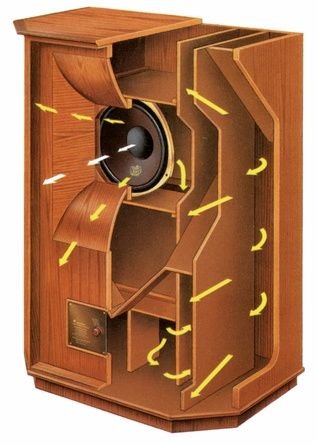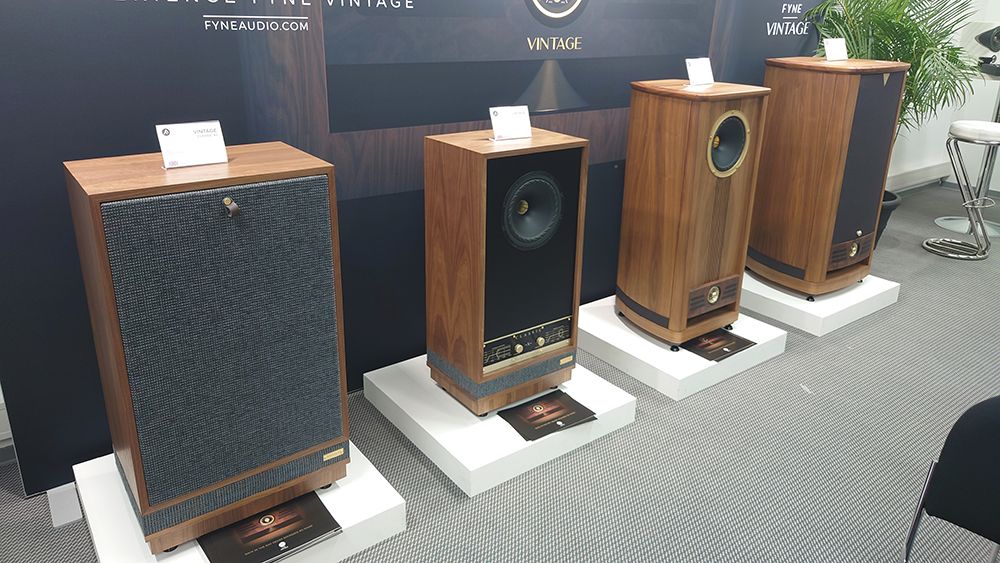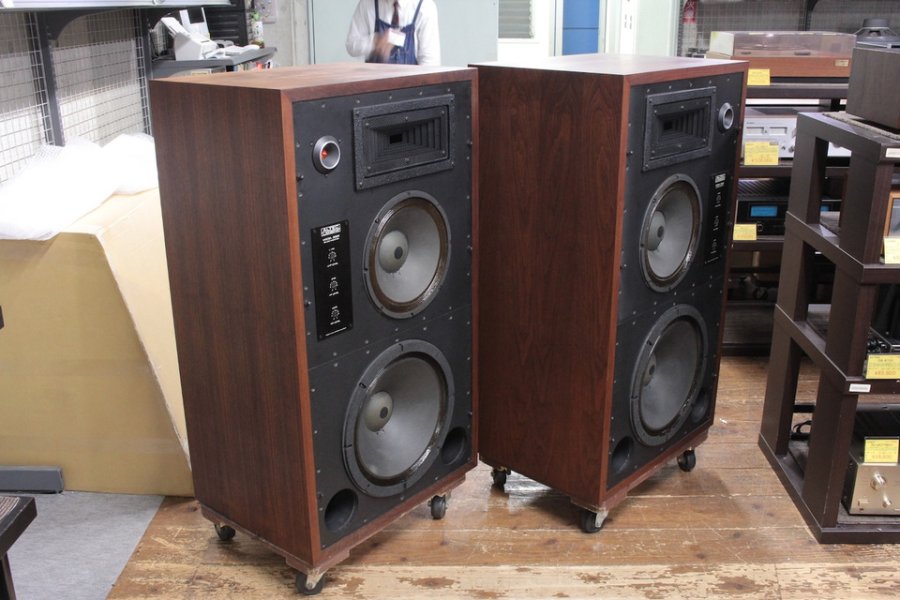...man, I saw those little R2D2 piglets in the demo "aquarium" they had in Penn Sta. or Grand Central some years back. They were freaky and thumping all kinds of bass in that glass room, their side "gills" pumping like pollywog Blade-Runner creatures. You should definitely get two and put them in your listening room, Gary. Absolutely.
The Ugly Truth Behind Hi-Fi's Growing Infatuation For Nostalgia
- Thread starter Ron Resnick
- Start date
You are using an out of date browser. It may not display this or other websites correctly.
You should upgrade or use an alternative browser.
You should upgrade or use an alternative browser.
This is my bullet point take on "retro looking speakers"
Form follow function. Wide baffle, large woofer speakers offer a tonal balance that is very appealing to many people. Sure they image differently from narrow baffle speakers but that is not a trade off at all if the listener simply is not turned on by the way skinnies image. In last year's HK show, I thoroughly enjoyed the Tannoy presentation that had a room permeating warmth to it. I was much less enamored with Fyne because with the amps used (sorry forgot which) seemed to want to blow up the cabinets from the inside.
As for tube gear, again form follows function. Kind of stupid to make a tube amp not look like a tube amp since the tubes need ventilation and the transformers need to be nearest to the terminals.
Don't even get me started on vinyl because while vinyl isn't for everyone, very rarely is it because of sound quality!
Maybe the author is a self proclaimed futurist. If that is the case then I hope he enjoys the idiocy of having to either talk to his car or go through a menu just to adjust the AC through a touch screen when a simple knob or switch would be more convenient but more importantly......SAFER.
On the flip side, I do get sad when I see venerated trademarks from yesteryear slapped on plastic crap you can buy at your nearest Target.
Altec Lansing palm sized bluetooth speaker anyone?
Form follow function. Wide baffle, large woofer speakers offer a tonal balance that is very appealing to many people. Sure they image differently from narrow baffle speakers but that is not a trade off at all if the listener simply is not turned on by the way skinnies image. In last year's HK show, I thoroughly enjoyed the Tannoy presentation that had a room permeating warmth to it. I was much less enamored with Fyne because with the amps used (sorry forgot which) seemed to want to blow up the cabinets from the inside.
As for tube gear, again form follows function. Kind of stupid to make a tube amp not look like a tube amp since the tubes need ventilation and the transformers need to be nearest to the terminals.
Don't even get me started on vinyl because while vinyl isn't for everyone, very rarely is it because of sound quality!
Maybe the author is a self proclaimed futurist. If that is the case then I hope he enjoys the idiocy of having to either talk to his car or go through a menu just to adjust the AC through a touch screen when a simple knob or switch would be more convenient but more importantly......SAFER.
On the flip side, I do get sad when I see venerated trademarks from yesteryear slapped on plastic crap you can buy at your nearest Target.
Altec Lansing palm sized bluetooth speaker anyone?
I agree completely with Tucker completely. Retro 70's looking speakers are drawing in a new and younger audience. Take a walk through Williamsburg, Brooklyn bars, and coffee shops and you will see vintage speakers playing everywhere. Look at the success Klipsch is having with their old-school speakers with updated driver technology, or JBL with L-100 derivatives. IMHO, anything that brings new blood and a younger audience (which 30-40 year-olds with discretionary income certainly are) into the hi-fi hobby is good for everyone. If it takes an "everything old is new again" approach so be it.
Big n' warm sound has always been the entry point while hard and screechy has always been the biggest turn off.
I just hope the majority of "retro" looking speakers are indeed big and warm sounding and not just big and muddy. THAT would be a shame.
OK, MB, but I'll do it kicking and screaming...man, I saw those little R2D2 piglets in the demo "aquarium" they had in Penn Sta. or Grand Central some years back. They were freaky and thumping all kinds of bass in that glass room, their side "gills" pumping like pollywog Blade-Runner creatures. You should definitely get two and put them in your listening room, Gary. Absolutely.
+1hard and screechy has always been the biggest turn off.
Happy New Year to you, Margie and the family, Jack!I thoroughly enjoyed the Tannoy presentation that had a room permeating warmth to it.
I have two friends who used to have the Westminster RG (to my eyes the second most unattractive loudspeaker I've ever seen in my life).
But it projected natural and organic low frequencies that put many high-tech contemporary loudspeakers to shame.
Westminster uses a backloaded horn, which when well designed, gives some of the best bass.Happy New Year to you, Margie and the family, Jack!
I have two friends who used to have the Westminster RG (to my eyes the second most unattractive loudspeaker I've ever seen in my life).
But it projected natural and organic low frequencies that put many high-tech contemporary loudspeakers to shame.
Westminster uses a backloaded horn, which when well designed, gives some of the best bass.
I like the bass of my corner horns. I do not really know if they are considered front or back loaded or some combination. I have never heard the Westminster. I think they’re great looking too. Like furniture.
Last edited:
I am not actually sure if these are back or front loaded horns. There is no forward facing direct radiation. This means it is like a Klipschorn or JBL Hartsfield, which are both front loaded folded horns.I like the bass of my back loaded corner horns. I have never heard the Westminster. I think they’re great looking too. Like furniture.
Westminster had both front loaded horn for midrange and a longer backloaded horn for bass.
I am not actually sure if these are back or front loaded horns. There is no forward facing direct radiation. This means it is like a Klipschorn or JBL Hartsfield, which are both front loaded folded horns.
Westminster had both front loaded horn for midrange and a longer backloaded horn for bass.
The dual concentric driver loads the internal folded horn whilst also directly radiating the upper registers into the room Viz :

Ron , In the main the output of the internal folded bass horn egress via the two slightly angled vents on the front corners of the cabinet , note the three arrows morphing into four arrows to the right side of the illustration posted above .
Last edited:
This guy is bitching at IAG for no good reason.
The ugly truth behind hi-fi's growing infatuation with nostalgia
What's the fascination with retro?www.whathifi.com
This seems to me to be a broadside and somewhat uneducated attack on currently manufactured products grounded in vintage design philosophies.
I find the article a bit incoherent, and I'm not even sure what "ugly truth" the author thinks he's exposing.
Am I reading this wrong?
He refers to his Art Audio Quintet amplifier. I've heard it many times, a friend had one (with Lockwood Tannoy's) and I've heard it at Tom Willis's house (Tom is Art Audio). It's a nice enough EL34 amplifier within its limitations that could have been built in 1930 (Tom's words). I've owned better Art Audio amplifiers (a 300B-XLS Jota and and KT88 Concerto Monoblocks). Nice in the middle, flabby bass because I don't have coffin-sized speakers.
I'm a big fan of IAG. I've owned Luxman, Quad ESL, Quad amplifiers and Audiolab M-DAC+ and M-One. They have a state of the art factory in Guangdong. They respect the brands they've acquired and focus them on specific markets rather than trying to sell everyone the same thing. Luxman is largely left to do what it does well, most of the design work on other brands is done by a team going back decades at their base in Huntingdon, UK. Mainly Peter Comeau and Rob Flain. One of their most successful products, the Audiolab MDAC, was designed by John Westlake, who was also responsible for the DacMagic for Cambridge Audio and some of Project's best amplifiers.
You can send any Quad product back to IAG in Huntingdon and they will service it, Whether Quad II from 1948 or 33/303's from the 1970s. The latter have remained popular and they have just reissued them, an honest improvement on the original design at a sensible price. I've sent them 909's for a complete recap and refurb at a cost of under $150.
After lots of esoteric hifi companies making audio bling have gone bust, IAG will be making honest hifi for sensible audiophiles and normal people offering tremendous value.
The Musical Fidelity A1 was also recently reissued. I had one. It was a true design classic, a 25W Class A solid state amplifier designed by Tim de Pavaracini in sci-fi casework designed by Pentagram, one of the world's leading design agencies. It is a near copy, with one or two modifications to reduce the chances of it catching fire. The last time I saw one it was on fire.
EPOS is another matter. Great speakers from the late 1970s/early 1980s. I had a pair of ES14. The new EPOS is a completely different speaker just using the EPOS brand name. I briefly heard them at Radlett Audio, Dave Wren who's been in business over 50 years sold a lot of the original EPOS. He told me they are an excellent speaker, they just bought the brand name for some attention. It worked, but they sell because they are good speakers.
Wharfedale under Gilbert Briggs (1930s to early 1960s) was in its time perhaps the world's leading quality speaker business. It was a great brand name and was sold multiple times. A client of mine owned it in the 1980s (one of their salesmen was a chap called Simon Cowell). Reissuing the Linton makes perfect sense. It was probably Briggs' last design and they sold millions, a great speaker for the price, and it was reissued at an incredibly good price of £1,100. Compare that to Dynaudio, who reissued the Contour 1.1 (which I bought new for £400 around 1990) as the Heritage Special for £4,000 (now £4,750).
I was referring to the Vitavox CN-191, not the Westminster. I correctly described the WM in other posts.The dual concentric driver loads the internal folded horn whilst also directly radiating the upper registers into the room Viz :
View attachment 142825
Yes but the horn is loaded by the backward motion of the driver…hence the term “backloaded “.I believe the low frequencies on the Westminster RG come out the front of the cabinet.
Corner horns use the two walls as an extension of the horn mouth. Fast , crisp, love it, I once had something like that.. down to 20hz amazing good unfortunately I don't have two corners to set up today.I like the bass of my corner horns. I do not really know if they are considered front or back loaded or some combination. I have never heard the Westminster. I think they’re great looking too. Like furniture.
P.S you can stack them 2 per side
Last edited:
Westminster uses a backloaded horn, which when well designed, gives some of the best bass.
I was referring to the Vitavox CN-191, not the Westminster. I correctly described the WM in other posts.
It looks like the Westminster radiates some energy directly at the listener and some backwards into the folded horn. The CN-191 woofer fires into a chamber that is connected to a folded horn which exits on the sides along the front and side wall of the room. I don’t really know if the woofer output is a combination of front and back radiation entering the folded horn.
Oh, yes!Ron , In the main the output of the internal folded bass horn egress via the two slightly angled vents on the front corners of the cabinet , note the three arrows morphing into four arrows to the right side of the illustration posted above .
I didn't see your illustration before I wrote my post.
If I could choose a vintage speaker again, the Altec 9862 would be at the top of the list. It sounds so good with Sansui or Luxman tube amps. I was very impressed.View attachment 142838
Right, and just how much more musical enjoyment does one get when paying so much more for today's combinations? Combine those, the Sansui/Luxman with a Denon DD vintage table or one of the idlers, and you could be a very happy music listener.
| Steve Williams Site Founder | Site Owner | Administrator | Ron Resnick Site Owner | Administrator | Julian (The Fixer) Website Build | Marketing Managersing |







